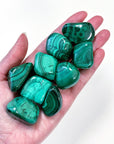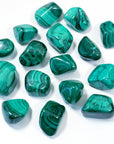


MALACHITE TUMBLE
This listing is for (1) malachite tumble, which will be intuitively selected. As these are natural stone, there is some natural variation in color, appearance and size. These are a beautiful quality.
Each is approx. 1"+; photo in my hand included for approximate scale.
The Mineral Maven LLC are not doctors and cannot give out medical advice. Healing crystals should be used as a complement to other therapies and not as a replacement for medical treatment, diagnosis, or examination. For medical advice, please consult a licensed healthcare specialist.
AVOID WATER & SELF CARE PRODUCTS
Avoid exposure to water (especially saltwater and chlorine), lotions, sprays, soap, etc because they can damage the elastic over time - and this can lead to snapping. Even the oils and sweat on our skin can wear out the elastic eventually.
Remove your bracelet when bathing, swimming, doing the dishes, etc. These activities can also dull the crystals.
STORAGE + CLEANING
Every bracelet comes with an organic cotton pouch for safe storage when not in use. Prolonged exposure to direct sunlight can cause crystals to fade over time. Keep your bracelet out of reach of children and pets, as they can easily snap the elastic.
Use a soft cloth (like microfiber) to wipe off oils, dust, or dirt. Avoid soap or harsh chemicals, and just use a damp cloth if needed. Allow your crystal bracelet to dry before wearing it again.
REMOVE BEFORE ROUGH ACTIVITIES
Avoid getting your bracelet caught on things by removing it before doing activities like playing with kids or dogs, yard work, exercise, etc. You can also wear them on your non-dominant hand to reduce chances of getting caught and snapping.
GENTLE HANDLING
The elastic can snap if handled roughly. Gently roll your bracelet over your hand when putting it on or taking it off, and avoid pulling or stretching too hard.



